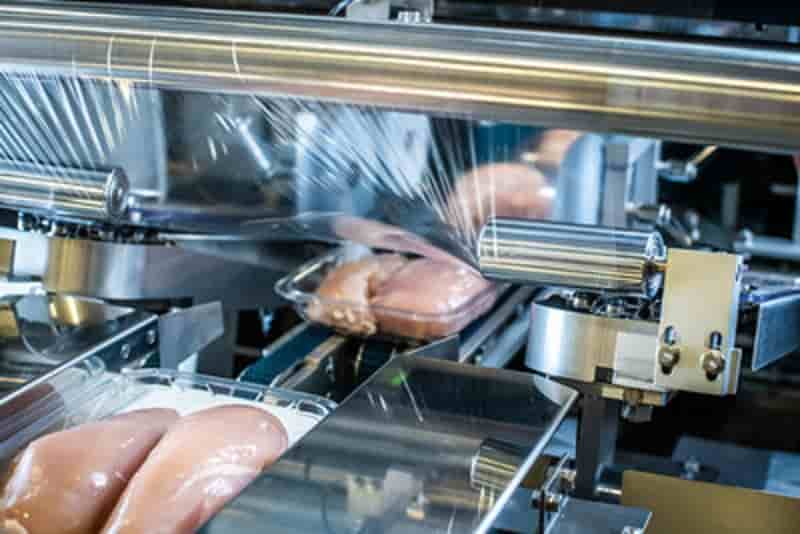Plastic recycling – Green hydrogen 04-05-2023 - Arhive
Plastic recycling – Green hydrogen
Crude Oil Prices Trend
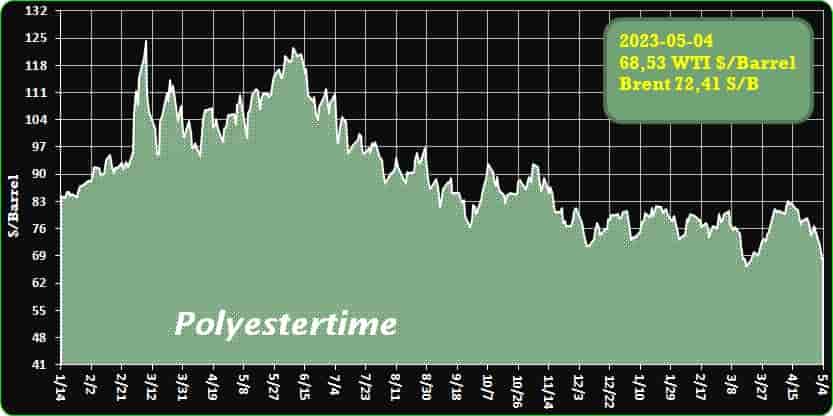
Crude Oil Prices Trend by Polyestertime
-Advanced Recycling: The Answer to Sustainable Packaging?
The need for a circular economy has never been so urgent. Plastic consumption is expected to double globally by 2050, creating environmental and human health risks. Not only is plastic waste overflowing in landfills, but a significant portion is mismanaged and leaks into the environment: the OECD estimates that nearly 80 million tonnes of plastic waste was mismanaged globally in 2019. With single-use packaging composing a significant amount of plastic waste generated annually, demand for more circular packaging options is taking off.
The most straightforward method to increase the sustainability of single-use plastic packaging is to increase its recycled content. However, mechanically recycled plastics face challenges in their application in packaging, particularly for fast-moving consumer goods (FMCG). Some of the biggest challenges include the degradation of mechanical properties with recycling, which causes recycled plastic to be “downcycled” from packaging to other applications, and contamination, which can make recycled plastic unsuitable for many food-contact applications. Plastic recycling – Green hydrogen
Given these issues, advanced recycling has emerged as a potential solution. The allure of advanced recycling methods, like solvent extraction, pyrolysis, and depolymerization, is that they use thermochemical reactions to allow used plastic waste to be made into “new” virgin plastic, circumventing the issue of downcycling. Additionally, mixed plastics that can be difficult to separate can be processed with advanced recycling methods and converted into plastics suitable for packaging. For these reasons, many view advanced recycling as the future “answer” to sustainable plastic packaging demand. But is this really the case? IDTechEx’s latest report, “Sustainable Packaging Market 2023-2033”, explores this question and evaluates the real potential of advanced recycling for sustainable packaging applications.
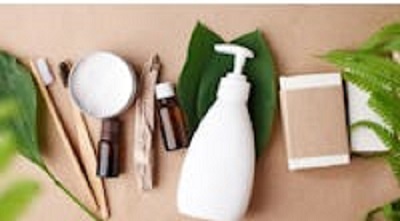
-Liquid-metal-coated smart fabric ‘heals’ itself when cut, repels bacteria
Science continues to advance smart fabrics that respond to environmental changes, and provide more ‘services’ to their wearers. Now, a team of international researchers has created a wearable textile that repairs itself, is antibacterial, and could even be used to monitor a person’s heart rhythm.
Researchers from the US, Australia, and South Korea created the highly conductive textile by dipping it in liquid metal (LM) particles. Plastic recycling – Green hydrogen
LM particles have many advantages: high heat and electrical conductivity, low toxicity, and antimicrobial properties. The gallium-based liquid metals the researchers used as part of this study remain in a liquid state at room temperature, meaning that, unlike solid metals, they can be molded onto surfaces in unconventional ways.
The researchers dip-coated the fabric with LM particles, which ensured the textile’s pores were not clogged, making it ‘breathable.’ They found that applying force to the LM-coated textile ruptured the non-conductive, oxygen-based layer that formed after dip-coating, making the particles conductive.
Adding more coats of the LM particles made the fabric more conductive, and the pathways maintained their conductivity even when the fabric was cut.
“The conductive patterns autonomously heal when cut by forming new conductive paths along the edge of the cut, providing a self-healing feature which makes these textiles useful as circuit interconnectors, Joule heaters and flexible electrodes to measure ECG [electrocardiogram] signals,” said Vi Thanh Truong, corresponding author of the study.
Joule heating, also known as resistive, resistance, or Ohmic heating, creates heat by passing an electric current through a conductor. Plastic recycling – Green hydrogen
The researchers used their new textile to make fabric ECG electrodes, used to monitor heart rhythm, and found they performed as well as commercially available gel-based electrodes.
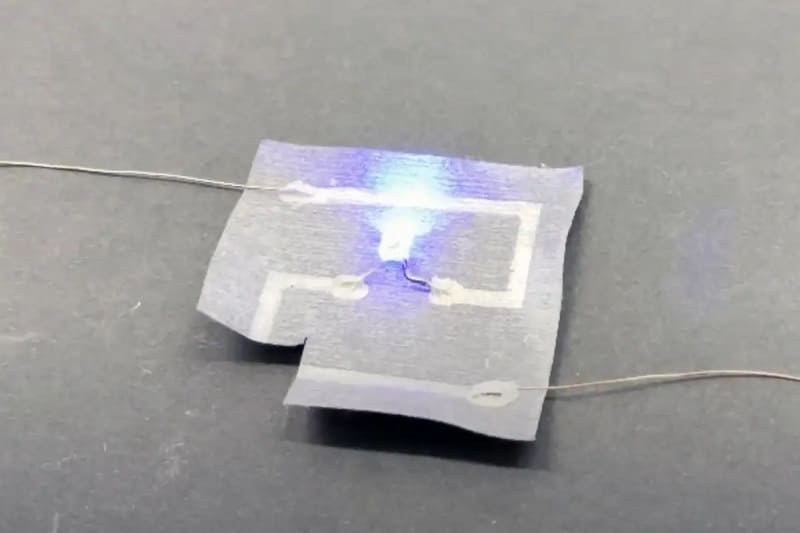
-BASF Unwraps Home-Compostable Food-Packaging Biopolymer
The biopolymer coating reportedly achieves polyethylene-like performance in paper packaging for hot and cold beverages and dairy products while gaining ground for the circular economy.
Manufacturing paper consumes more energy and water and emits more greenhouse gases than plastics. It also contributes to deforestation, which, ironically, was a reason that plastic bags became so popular in the first place. But despite science-based evidence to the contrary, paper largely is seen by the public at large as an environmentally preferable substitute for plastics. To retain customers and attract new ones, brand owners are left to find ways to make paper perform as well as plastics, which has been a challenge. Paper straws immediately come to mind. Plastic recycling – Green hydrogen
There are also a number of food-contact packaging applications, where paper simply lacks the required properties. Often, a polymer-based liner is needed, which most consumers are unaware of, that makes recycling of the container that much more difficult. BASF has one answer to this dilemma: It has added a grade to its ecovio portfolio that is compostable in both home and industrial environments. It reportedly matches the properties of plastic packaging while advancing the circular economy.
Extrusion coating grade ecovio 70 PS14H6 has excellent barrier properties against liquids, fats, grease, and mineral oil, according to BASF, and is stable at temperatures from -40° to 100°C. The material adheres to many types of paper and board.
Ecovio materials, which are a blend of biodegradable PBAT polymers and renewables, are certified to be compostable in accordance with DIN EN 13432 and other standards, said BASF. Plastic recycling – Green hydrogen
Claiming that the new grade performs better than currently available biopolymers, BASF also notes that additional barrier properties can be achieved via mono- or multi-layer extrusion without adhesives. Coating line speeds reportedly are comparable to polyethylene, and similar coating weights, including very thin layers, are possible.
“There is a big trend in society — in some countries driven by legislation — to move from pure plastic to paper-based packaging, which in itself is not suitable for a lot of different foods, especially with liquid or fatty ingredients,” said Michael Bernhard Schick, who handles global marketing of biopolymers at BASF. “We offer a strong and at the same time sustainable packaging solution for hot, frozen, or chilled food.
Ecovio 70 PS14H6, thus, combines excellent technical performance with the decisive added benefit of home-compostability for paper packaging, supporting organic recycling of food waste.” Plastic recycling – Green hydrogen
Applications cited by BASF include cups and pots for dairy products and frozen goods, sandwich and cereal bar wrappers, snack bowls and trays, and to-go cups for hot or cold drinks and soups.
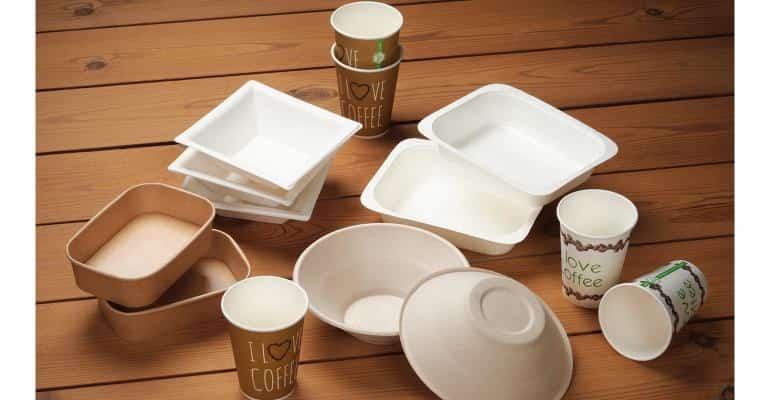
-Evonik will receive green hydrogen from Linde under a long-term agreement.
Linde will be responsible for building, owning and operating an alkaline electrolyzer plant with a capacity of nine-megawatts on Jurong Island, Singapore.
The plant will produce green hydrogen that will be used by Evonik to manufacture methionine, which is a vital component in animal feed.
The deal will enable Evonik to expand its existing facility while reducing greenhouse gas emissions in Singapore. Linde will also supply green hydrogen to the local merchant market in response to increasing demand.
The Jurong Island electrolyzer plant is scheduled to become operational in 2024 and will be the most extensive electrolyzer ever installed in Singapore.
It is worth noting that Linde has been selected by Dow as its industrial gas partner to provide clean hydrogen and nitrogen for its proposed net-zero carbon emissions integrated ethylene cracker and derivatives site in Fort Saskatchewan, Alberta, Canada.
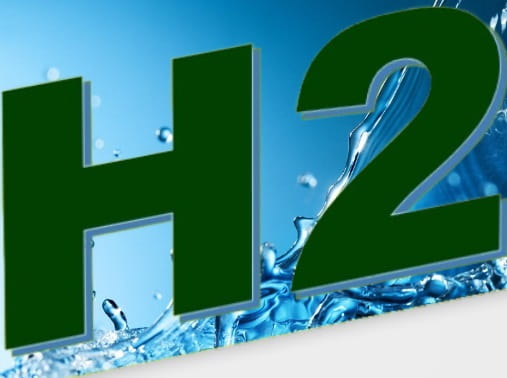
Green Hydrogen by Polyestertime
-Plastic recycling
Plastic recycling refers to the process of recovering plastic waste and transforming it into new products.
The aim of plastic recycling is to reduce the amount of plastic waste in the environment and conserve resources by reusing plastic materials. The plastic recycling process typically involves the following steps:
- Collection: Plastic waste is collected from various sources such as households, businesses, and industries.
- Sorting: The collected plastic waste is sorted based on its type and quality.
- Cleaning: The plastic waste is cleaned to remove any contaminants such as dirt, food, or labels.
- Shredding: The cleaned plastic waste is shredded into small pieces or flakes.
- Melting: The shredded plastic is melted and processed into pellets.
- Manufacturing: The pellets are then used to manufacture new products such as containers, furniture, and textiles. Plastic recycling – Green hydrogen
Plastic recycling has many benefits, including reducing the amount of plastic waste in landfills and oceans, conserving resources, and reducing greenhouse gas emissions. However, it is important to note that not all types of plastic can be recycled, and the process can be expensive and energy-intensive. Therefore, reducing plastic consumption and properly disposing of plastic waste are also important steps in addressing the plastic pollution problem.
Kinds of plastic sorting:
There are several kinds of plastic sorting methods, including:
- Manual Sorting: In this method, plastic items are sorted by hand based on their appearance and texture.
- Automated Sorting: This method involves the use of machines equipped with advanced sensors and cameras that detect the type of plastic based on its properties such as density, reflectivity, and color.
- Near-Infrared (NIR) Sorting: NIR technology uses near-infrared light to identify different types of plastics based on their chemical composition.
- Magnetic Sorting: This method uses magnets to separate ferrous and non-ferrous materials, which helps to sort out plastic items that have metal components. Plastic recycling – Green hydrogen
- Electrostatic Sorting: In this method, plastic items are charged with an electrical charge, and the differently charged materials are then separated based on their electrostatic properties.
- Density Separation: This method involves the use of water to separate plastics with different densities. Plastic items are placed in water, and those with different densities float or sink, making it possible to separate them.
These sorting methods are crucial in the recycling industry, as they help to ensure that different types of plastics are processed and recycled effectively.
Kinds of chemical recycling :
Chemical recycling refers to the process of breaking down plastic waste into its basic chemical building blocks, which can then be used to create new plastics or other products. There are several types of chemical recycling, including:
- Pyrolysis: This is a process where plastic waste is heated in the absence of oxygen, causing it to break down into its basic chemical components, such as oils and gases. These components can then be used to create new plastic products or fuel. Plastic recycling – Green hydrogen
- Depolymerization: In this process, plastic waste is broken down into its monomer units through a chemical reaction. The resulting monomers can be used to create new plastics or other materials.
- Gasification: This process involves heating plastic waste in the presence of a gas, such as oxygen or steam, to produce a synthetic gas. The synthetic gas can then be used as a fuel or to create chemicals for use in other products.
- Solvolysis: This process involves breaking down plastic waste using a solvent, such as ethanol or methanol, to separate it into its chemical components.
Chemical recycling has the potential to significantly reduce the amount of plastic waste in the environment and conserve resources by creating new products from old materials. However, it can be expensive and energy-intensive, and the technology is still in its early stages. It is important to continue developing and improving these technologies to make them more efficient and cost-effective. Plastic recycling – Green hydrogen
Kinds of mechanical recycling :
Mechanical recycling is a process that involves using physical and mechanical methods to transform plastic waste into new plastic products. There are several types of mechanical recycling, including:
- Shredding: In this process, plastic waste is shredded into small pieces, which are then cleaned and melted down to create new plastic products.
- Washing: Plastic waste is washed to remove contaminants such as dirt and food residue before being shredded and melted down.
- Agglomeration: This involves heating plastic waste until it becomes a sticky mass, which is then cooled and cut into pellets. These pellets can be melted down and used to create new plastic products.
- Extrusion: This process involves melting plastic waste and extruding it through a die to create a new product with a specific shape and size.
- Injection molding: In this process, melted plastic is injected into a mold to create a new product with a specific shape and size.
Mechanical recycling is a valuable process for reducing plastic waste and promoting sustainability, but it has limitations. For example, it is not always possible to recycle certain types of plastics, and the quality of the recycled plastic may not be as high as that of virgin plastic.Inizio modulo Plastic recycling – Green hydrogen
Kinds of recycling both no chemical and mechanical :
There are two primary types of recycling that do not involve chemical or mechanical processes:
- Biological Recycling: This type of recycling involves using natural processes, such as composting or anaerobic digestion, to break down organic materials and convert them into a nutrient-rich soil amendment. Organic materials such as food waste, yard waste, and even some types of paper products can be recycled in this way.
- Upcycling: Upcycling involves transforming waste materials into new products that have a higher value or utility than the original material. For example, discarded textiles can be turned into new clothing or home decor items, and reclaimed wood can be transformed into furniture or other decorative pieces.
Both biological recycling and upcycling are eco-friendly methods of recycling that can help reduce waste and conserve resources. Plastic recycling – Green hydrogen
These methods are often seen as more sustainable than mechanical or chemical recycling processes because they do not require large amounts of energy or resources to break down or transform the materials.
Plastic production has been steadily increasing over the past few decades, and it is expected to continue to grow in the coming years. According to the International Energy Agency (IEA), global plastics production reached 368 million tonnes in 2019, and it is projected to double by 2050.
The growth in plastic production is driven by factors such as population growth, urbanization, and rising consumer demand for plastic products. However, this growth has also contributed to a significant increase in plastic waste and pollution, leading to concerns about the environmental impact of plastic production and disposal.
To address these issues, many governments, companies, and organizations around the world are working to promote plastic recycling, reduce plastic use, and find alternative materials and packaging solutions. Plastic recycling – Green hydrogen
Polyester production
Polyester is a synthetic fiber that is widely used in the textile industry for clothing, bedding, and other products. According to a report by Grand View Research, the global polyester market size was valued at USD 85.08 billion in 2020 and is expected to grow at a compound annual growth rate (CAGR) of 6.5% from 2021 to 2028.
The growth in the polyester market is driven by factors such as the increasing demand for textiles, rising disposable income, and changing fashion trends. However, the production and disposal of polyester can have negative environmental impacts, such as greenhouse gas emissions and plastic waste.
To address these issues, some companies and organizations are exploring alternative materials and manufacturing methods, such as recycled polyester and bio-based polyester. These efforts aim to reduce the environmental impact of polyester production and promote more sustainable textile practices. Plastic recycling – Green hydrogen

-Loop Industries and Garnier have partnered to produce a limited-edition recycled PET (rPET) bottle made from nonrecyclable plastic waste for Garnier’s Micellar Cleansing Water All-In-1 cleanser.
Loop Industries used its Infinite Loop technology to depolymerize PET waste, including plastic that cannot be recycled through conventional recycling processes, and low-value waste like colored and opaque PET bottles. The depolymerized waste was then repolymerized into 100% recycled, virgin-quality PET resin suitable for food-grade packaging and polyester-fiber applications. The resulting rPET bottles are 100% recycled and recyclable, showcasing how nonrecycled PET waste can be repolymerized to support plastics circularity.
The key benefit of repolymerizing nonrecycled PET waste is the prevention of waste in landfills, oceans, and incinerators. Additionally, the rPET bottles produced through this process are infinitely recyclable if sorted correctly. The limited-edition Garnier bottles feature Loop’s logo on the front and language explaining that they are made from 100% recycled PET. Plastic recycling – Green hydrogen
Garnier’s global brand president, Adrien Koskas, expressed pride in the company’s partnership with Loop Industries, stating that “this technology has the potential to change the game when it comes to recycling,” and that the partnership demonstrates Garnier’s continued efforts to bring more environmentally friendly packaging to market. Garnier also reports that it avoided using 12,200 tons of virgin plastic in 2021 by using recycled plastic, and 31% of its annual plastic consumption was recycled plastic.
The Micellar Cleansing Water bottles launched in April 2023 in the US and France, and 20,000 Garnier x Loop Micellar Water bottles were produced for this limited-edition launch. The Loop bottles will be available while quantities last. The closure of the bottle is currently polypropylene, but Garnier is working on rolling out a cap made of recycled PP on Micellar Cleansing Waters.
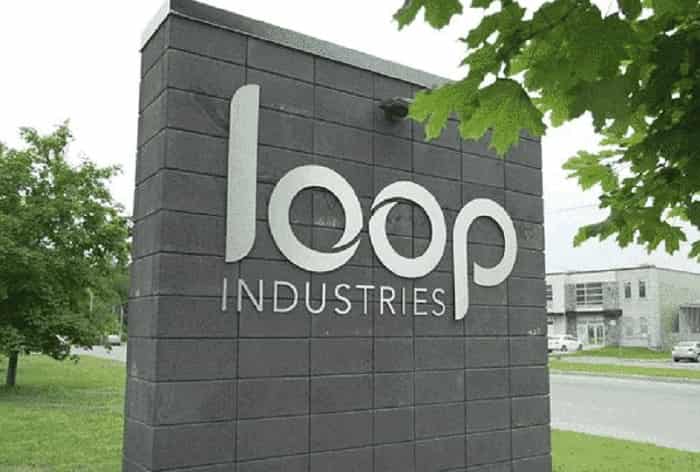
-Metaspectral gets $419K in new funding for advanced sorting technology
Metaspectral, a Canadian software company founded in 2018, has received $419,000 in new funding from the CleanBC Plastics Action Fund.
The company has developed artificial intelligence technology that uses deep learning and hyperspectral imagery to sort previously unidentifiable materials at the polymer level in real-time.
This enables large quantities of plastic to be sorted and recycled more efficiently and accurately at recycling facilities.
Metaspectral’s Fusion platform is already being used by the largest recycling company in Canada. Plastic recycling – Green hydrogen
The new funding will be used to develop the technology further, with a focus on differentiating homopolymer high-density polyethylene (HDPE) from copolymer HDPE.
This will enable milk containers, which were added to British Columbia’s deposit-refund system in 2022, to be recycled more effectively.
The Government of Canada aims to require plastic packaging to contain at least 50% recycled content by 2030.
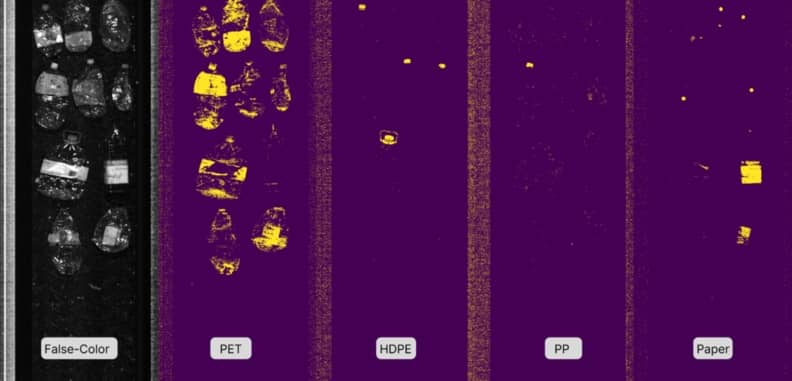
-Circular Food-Grade Packaging Proves Successful with Advanced Recycling
ExxonMobil, Cyclyx, Sealed Air, and Ahold Delhaize USA have demonstrated the success of advanced recycling for plastic waste in circular food-grade packaging, which is currently being evaluated for scale.
In 2022, industry leaders announced their intention to launch a circular food packaging proof-of-concept in the US, which was successfully demonstrated by collecting plastic waste from grocery stores and diverting it from landfills.
The advanced recycling process leverages ExxonMobil’s Exxtend technology, which breaks down plastic waste into its molecular building blocks and attributes them to new plastic for food-grade packaging using a mass-balance approach.
The collaboration has shown that creating a circular economy for food contact plastic packaging, where there are strict safety and performance requirements, is achievable with value chain collaboration.
During the initial pilot, plastic waste was collected at select Food Lion store locations, and Ahold Delhaize USA brand Food Lion supported the project.
Cyclyx, a joint venture between Agilyx Corporation and ExxonMobil, sorted and pre-processed the waste packaging materials collected from the Food Lion stores before delivering them to ExxonMobil’s Baytown, TX, facility.
At the Baytown facility, the Exxtend technology for advanced recycling was used to recycle the valuable end-of-life plastics and attribute them via mass balance accounting to certified-circular polymers.
The resulting polyethylene polymers have the characteristics of virgin resins, which is critical for food-grade packaging.
Sealed Air converted the certified-circular PE resins into food-grade flexible film that is used to package select Nature’s Promise fresh poultry, and the packaging is returned to stores for use on products purchased by customers, demonstrating an example of the circular economy.
ExxonMobil plans to increase its annual advanced recycling capacity to 500,000 metric tons, or approximately 1 billion pounds, by year-end 2026 across multiple sites globally to meet the growing market demand for certified-circular plastics.
This project helps demonstrate how advanced recycling is making the impossible possible and is an important enabler to support a circular economy.
